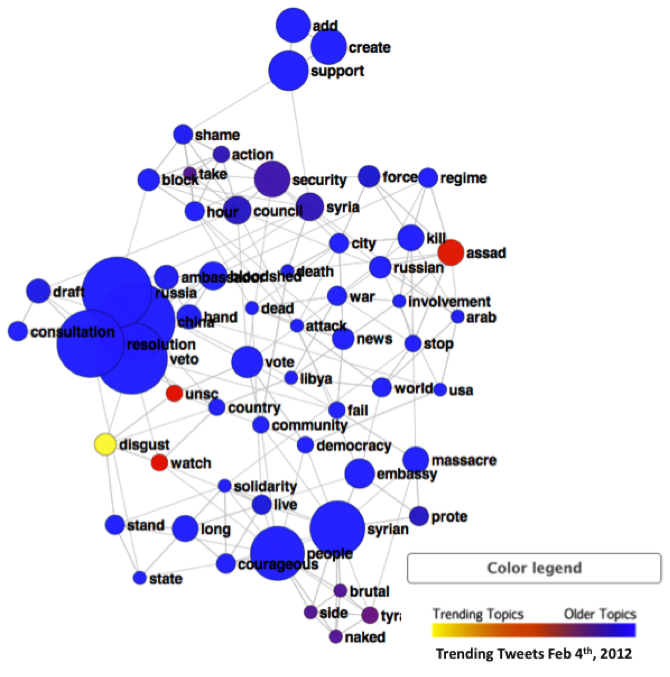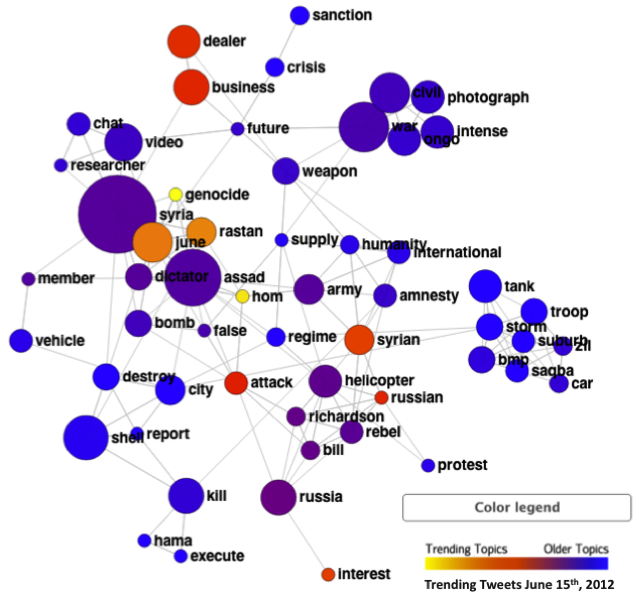Introducing the Digital Diplomacy Bibliography Digital social media technologies have become part of people’s everyday life. They also have an impact on diplomatic practice and the way governments engage foreign publics...
KEEP READINGThe CPD Blog is intended to stimulate dialog among scholars and practitioners from around the world in the public diplomacy sphere. The opinions represented here are the authors' own and do not necessarily reflect CPD's views. For blogger guidelines, click here.
Public Diplomacy and Twitter: Syria then and now
By Zachary Devereaux and Thomas Ledwell, Nexalogy Environics
Can a multilateral solution to a violent conflict take place without taking social media into account? Philip Seib argues, “The days of stately diplomatic process are long gone, and a public diplomacy initiative that lags too far behind the media flow may be ineffective. Transparency, long considered annoying and even dangerous by many diplomats, is increasingly expected by information consumers and can be driven by YouTube, Twitter, and other social media.” (Seib, 2011) Looking at online discussions about Syria since the beginning of 2012, Seib’s theory appears to bear true, as conversations that began in the realm of the official evolved into conversations laden with public opinions.
The Veto As Turning Point
In February, the standoff between the Syrian people and the regime of Bashar al-Assad was descending into even more violence. The international community was taking notice. With the lasting effects of last year’s Arab Spring still rippling through the Middle East, commentators and the international diplomatic community took aim at Syria. The Syria question took center stage as the United Nations Security Council drafted a resolution to decide whether to intervene in Syria.
At that time, Nexalogy showed the growing prevalence of conversations on social media, and in particular Twitter, regarding the situation in Syria. Nexalogy’s social media analysis technology identifies top concepts, actors, and shared content taking place in large-scale social media conversations, in this case concerning Syria on Twitter.
The discussion peaked with conversation about the UN Security Council vote. As we now know, that resolution died after Russia and China invoked their right to veto. That moment marked a turning point in the conversation on social media, with public diplomacy being carried out by major figures on Twitter. As the U.S. ambassador to the U.N., Susan Rice, posted, “The courageous people of #Syria can now clearly see who supports them, and who does not.” Though Rice takes a position on the side of the Syrian people, this post still fits within the dominant discourse of the international impasse over the UN resolution.

Figure 1
Turning Phrases Through Social Media
More recently, Nexalogy again investigated the public discussions, in English, taking place around the subject of Syria. By June, the UN observers had failed to maintain a cease-fire between the Syrian Free Army and the al-Assad regime. Online discussions peaked once again. This time, in terms of public diplomacy, new groups emerged, introducing a more grassroots perspective to the conversation on a large scale. Comparing the types of actors present in online conversations between February and June shows that public discussion of international crises is indeed active on social media networks. During that period, the dynamics of the conversation evolved in reaction to events happening on the ground in Syria and in diplomatic circles. However, unlike the heavy involvement of public diplomats in discussions in February, the June conversations featured a multitude of citizens, many of them outside of Syria.
These participants created and circulated messages aimed at increasing awareness of the conflict. Following that shift, the language in the posts also took on a less diplomatic tone. The shift in language was most clear on June 15. On that day, the term "genocide" was a trending concept related to Syria on Twitter. This was a departure from the more guarded language used in earlier discussions, when officials held a more significant place in the conversation both as actors and as the subject of tweets. The scale and volume of conversation continues to be significant. Extracting the major themes and following trending topics is integral to understanding the evolution of public opinion on social media channels.

Figure 2
Table 1.
Comparison of trending words in relation to Syria on Twitter in February 2012 and June 2012

The Buzz-Diplomacy Link
The research shows that we can measure the volume and topics of social media discussions and demonstrate that official diplomacy can be translated into public opinion, which has an impact on the diplomacy related to the conflict. Seib argues that, “when policy determinations are made, the world may learn about them within minutes from a variety of sources that may feature a variety of slants on the information.” (Seib, 2011 ).
Clearly, new environments for public diplomacy are changing the debate and evolving in their own right. These environments are wired, international and round-the-clock. Being able to identify the grassroots messages that have the potential to change the debate and the official messages that amplify those signals has enormous potential for public diplomacy. The question remains as to the consequences of ignoring these political discussions that are taking place on and through social media, which continue regardless of whether or not official actors take heed. Ultimately, the social media discussion of Syria reflects the importance of taking public dialogue into account when attempting to mediate a multilateral solution to violent conflict. Moreover, the ability of social media conversations to frame the debate is an essential component of public diplomacy.
Visit CPD's Online Library
Explore CPD's vast online database featuring the latest books, articles, speeches and information on international organizations dedicated to public diplomacy.
POPULAR ARTICLES
-
December 17
-
January 2
-
December 15
-
November 25
-
January 2
Join the Conversation
Interested in contributing to the CPD Blog? We welcome your posts. Read our guidelines and find out how you can submit blogs and photo essays >.













